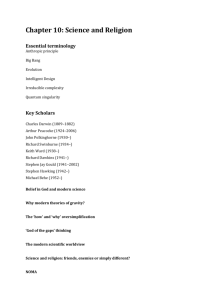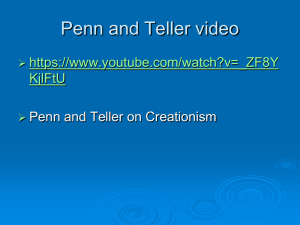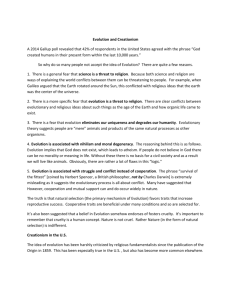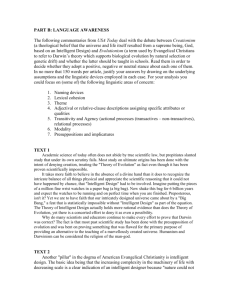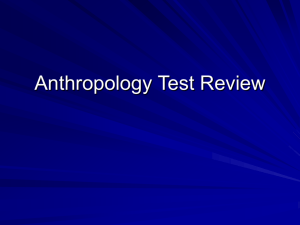Evidence for Evolution
advertisement
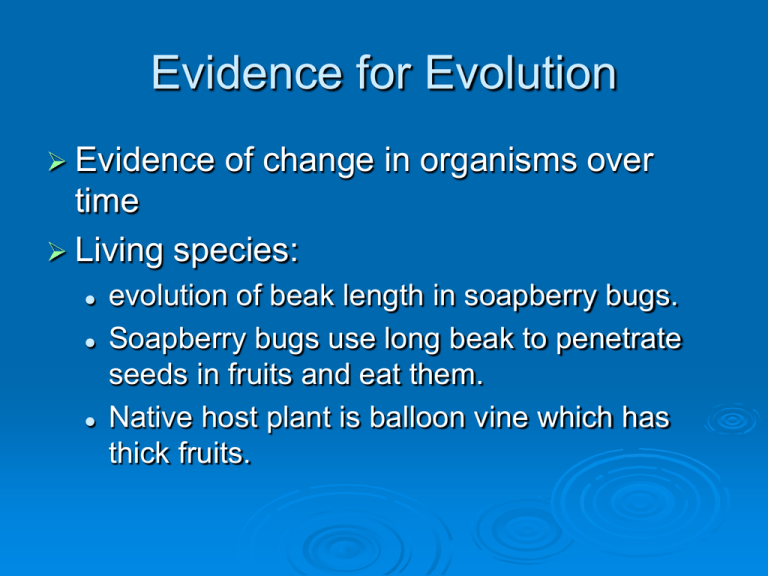
Evidence for Evolution Evidence of change in organisms over time Living species: evolution of beak length in soapberry bugs. Soapberry bugs use long beak to penetrate seeds in fruits and eat them. Native host plant is balloon vine which has thick fruits. Evolution of Soapberry Bugs In 1926 flat-podded Golden rain tree introduced to Florida. Has thin fruits. Today soapberry bugs feeding on Golden rain trees have much shorter beaks than those living on balloon vines. Comparison of beak lengths in areas with and without golden rain trees Data from museum specimens documents change in beak length over time. Vestigial organs Many organisms possess rudimentary or functionless versions of body parts that function in close relatives/ancestors Cave populations of Mexican tetra fish have eye sockets but no eyes. Kiwis have tiny, stubby wings Boas have tiny remnant hind limbs Human vestigial structures Coccyx: vestigial tailbone at base of spine. Arrector pili muscle at base of hair follicles makes hair stand up. Appendix: reduced in size. Used in digestion of cellulose in herbivores e.g. rabbits. Vestigial developmental trait Adult chickens: three bones in forefoot (wing), four in hindfoot. However, digit 5 appears briefly during embryonic development before disappearing. Molecular vestigial traits Human genome contains large numbers of pseudogenes that do not code for functional RNA or proteins. E.g. several pseudogenes of hemoglobin. May be as many as 6,000 pseudogenes in human genome. Fossil evidence of evolution Clear from fossil evidence that many (in fact almost all that have ever existed) species have become extinct. Fossil evidence of evolution Law of Succession: Fossil and living organisms in same area related to each other and differ from organisms in other areas. E.g. Australia filled with marsupials, fossils are of similar marsupial forms. South America contains both fossil and living armadillos Extinct glyptodont (2,000 kg) resembles modern-day armadillo (2 kg). Fossil evidence of evolution Transitional forms If fossil organisms ancestral to modern organisms then there should be transitional fossils that show characteristics intermediate between the older and more recent groups. Archaeopteryx Archaeopteryx the oldest known fossil bird (name means “ancient wing) has mix of reptilian and avian features. Reptilian: long tail, teeth, long clawed fingers Avian: feathers, ribs with uncinate processes, avian shoulder girdle. Archaeopteryx (oldest known fossil bird) Jurassic 180mya Evidence of common ancestry. Homologous structures Structures constructed from the same basic components. Forelimbs of human, mole, horse, dolphin and bat constructed from same bones, but used in radically different ways. Makes no sense if organisms specially created, but logical if organisms share a common ancestor. Homologous structures (i.e. derived from a common ancestor). Even though the forelimbs have evolved to carry out very different tasks they are all constructed from the same bones. FIG 2.11 Developmental Homology Embryos of diverse array of vertebrates very similar in early development Not all similarities due to homology. Streamlined shapes of fish and whale not a result of common ancestry but convergent evolution. FIG 2.12. Molecular Homology With few exceptions all organisms use same genetic code. Genetic flaws shared by species. Molecular Homology Chromosome 17 in humans PMP22 gene has duplicate sequence of DNA (CMT1A repeat) on either side of it. Result of duplication and insertion of DNA. Occasionally causes inaccurate crossing over during meiosis. Molecular Homology Humans share CMT1A repeat with bonobos and chimpanzees, but not gorillas, orang-utans or other primates. Suggests CMT1A derived from common ancestor of bonobos, chimps and humans. Other evidence for evolution Jerry-rigged structures e.g. The Panda’s thumb. Panda’s Thumb In Pandas, a wrist bone modified as tool to strip bamboo. Panda’s “thumb” not very efficient solution to Bamboo-stripping problem. Natural selection must work with the material available. “Thumb” implies pandas not designed, but evolved. Other evidence for evolution Adaptive radiation and clusters of species. Many remote islands populated by diverse, but closely related species. Adaptive radiation Ancestral colonist arrives on island. Shortage of resident species means many niches are unfilled. Ancestral species give rise to many species that occupy unfilled niches. Adaptive radiation Examples: Darwin’s finches on Galapagos Island, Drosophila on Hawaiian Islands. Darwin’s Finches On Galapagos Islands there are 13 species of anatomically very different, but closely related species of finch. They differ greatly in beak size and diet having evolved very different lifestyles. Hawaiian Drosophila More than 25% of the world’s 1,250 species of Drosophila fruit flies found on Hawaiian Islands. Few insect competitors so Drosophila have diversified to fill large number of niches. If faunas created, why are woodpecker finches, but not woodpeckers found on the Galapagos? Creationism and “Intelligent Design” The idea of evolution has been harshly criticized by religious fundamentalists since the publication of the Origin in 1859. This has been especially true in the U.S. Repeatedly, believers in the literal truth of the Bible have attempted to have alternatives to evolution (i.e., creationism) taught in the public schools and to have the teaching of evolution either banned or restricted. Creationism and “Intelligent Design” The U.S. Supreme Court has prohibited the teaching of creationism in public schools as a violation of the establishment of religion clause of the Constitution. Latest attempt to insert creationism into schools is the idea of “Intelligent Design.” Creationism and “Intelligent Design” The concept of “intelligent design” is outlined most clearly in Michael Behe’s book “Darwin’s Black Box.” The central idea in “intelligent design” is that some structures in the body are so complex that they could not possibly have evolved by a gradual process of natural selection. These structures are said to “irreducibly complex.” Creationism and “Intelligent Design” By “irreducibly complex” Behe means that a complex structure cannot be broken down into components that are themselves functional and that the structure must have come into existence in its complete form. Creationism and “Intelligent Design” If structures are “irreducibly complex” Behe claims that they cannot have evolved. Thus, their existence implies they must have been created by a designer (i.e. God, although the designer is not explicitly referred to as such). Creationism and “Intelligent Design” Behe’s main examples are various biochemical pathways in the body, the blood clotting system, and structures such as the bacterial flagellum. Creationism and “Intelligent Design” Since the publication of Behe’s book, it has been demonstrated repeatedly that things he has claimed to be irreducibly complex are not in fact so. E.g. the flagellum in eel sperm lacks several of the components found in other flagella, yet the flagellum functions well. Creationism and “Intelligent Design” The blood clotting system in dolphins lacks at least one component that the human system has, yet it too is functional. In addition, plausible gradual scenarios for the evolution of biochemical pathways including the Kreb’s cycle have been documented. Evolution of complex structures The evolution of complex structures, such as the eye, appears difficult, but natural selection achieves this by the slow accumulation of minor improvements from one generation to the next. Evolution of complex structures Each step on the evolutionary pathway from a simple light sensing cell to a complex eye capable of focusing and producing color vision, must be beneficial to the organism that possess it and a slight improvement on earlier versions. It is not necessary for a structure to be perfect or even very good it just needs to be better than the alternatives to be favored by selection. Variation in mollusc eyes from (a) pigment spot to (b) pigment cup to (c) simple optic cup in abalone to (d) complex lensed eyes in a marine snail and octopus. Evolution of complex structures Computer simulations suggest that eyes can evolve easily and in nature eyes have evolved independently more than 40 times.
